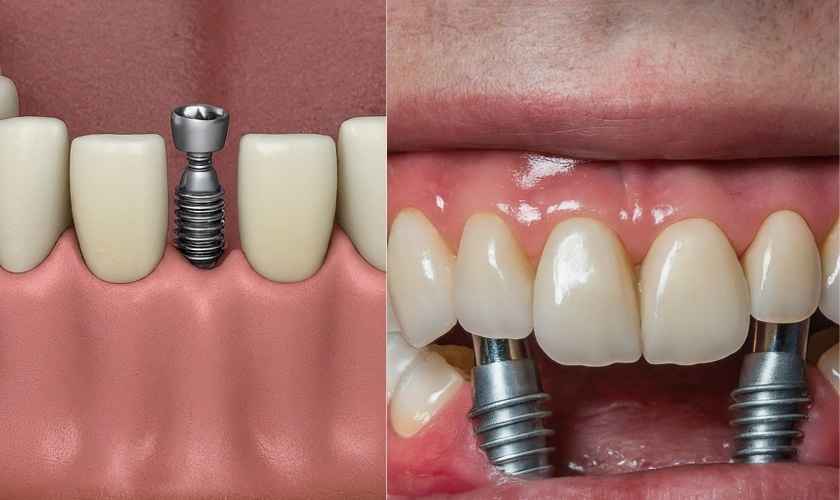Things about Dental Sense
Things about Dental Sense
Blog Article
Dental Sense Can Be Fun For Anyone
Table of ContentsDental Sense Fundamentals ExplainedGetting The Dental Sense To WorkThe Ultimate Guide To Dental SenseSome Of Dental Sense
are clinical tools surgically implanted right into the jaw to recover a person's ability to chew or their look. They provide support for man-made (phony) teeth, such as crowns, bridges, or dentures. When a tooth is shed because of injury or illness, a person can experience difficulties such as quick bone loss, defective speech, or changes to eating patterns that cause discomfort.Oral implant systems consist of a dental implant body and oral implant joint and might likewise include a joint fixation screw. Dental implant vs bridge. The dental implant body is operatively inserted in the jawbone instead of the tooth's origin. The dental implant joint is usually connected to the dental implant body by the joint addiction screw and prolongs with gum tissues right into the mouth to sustain the attached artificial teeth
(https://hearthis.at/matthew-music/set/dental-sense/)Framework of The Dental Implant System choosing dental implants, speak to your oral provider concerning the potential benefits and threats, and whether you are a prospect for the treatment. Things to consider: Your total health and wellness is an important aspect in identifying whether you are a great candidate for dental implants, for how long it will take to heal, and how much time the implant might stay in place.
Smoking cigarettes might impact the recovery procedure and lower the lasting success of the dental implant. The recovery procedure for the implant body might take a number of months or longer, during which time you generally have a temporary abutment in area of the tooth. the dental implant treatment: Very carefully follow the oral health instructions provided to you by your oral company.
Dental Sense for Dummies
Implant failure can result in the requirement for one more procedure to take care of or change the dental implant system. Recovers the ability to chew Brings back aesthetic appearance Aids maintain the jawbone from shrinking due to bone loss Maintains the health of the bordering bone and gums Helps maintain adjacent (nearby) teeth stable Boosts lifestyle Damages to bordering natural teeth during dental implant placement Injury to the surrounding tissues during surgery, such as sinus perforation Injury during surgical treatment (for example, crack of surrounding jawbone) Poor function, such as seeming like the teeth do not attack with each other typically A feeling that the tooth is loose or turning in position resulting from a joint screw loosening up Implant body failure (looseness of the dental implant body) as a result of systemic infection, which might be more probable in patients with uncontrolled diabetes mellitus as a result of local infection in bone and gums supporting the dental implant body as a result of postponed recovery, which might be most likely in people who smoke Problem cleaning up the gums around the implant, resulting in poor dental hygiene Neglected gum condition Post-surgical numbness because of nerve impingement or damage Constantly alert health treatment service providers and imaging specialists that you have dental implants prior to any magnetic vibration imaging (MRI) or x-ray treatments.
FDA is not familiar with any unfavorable events reported for MRI or x-ray treatments with dental implants. Dental implants systems are typically made of products that follow international agreement standards of the International Company for Standardization (ISO) or ASTM International. These criteria have information of what makes a secure material.

An oral implant is a framework that replaces a missing out on tooth. With screw-like gadgets, the surgeon inserts an implant into the jawbone, and it acts as a support for a fabricated tooth, called a crown.
The 10-Minute Rule for Dental Sense
Some people are not qualified for dental implant surgical procedure. It is for dental doctors to run on people with: severe illnessuncontrollable metabolic diseasebone or soft cells disease or infectionIf these problems are dealt with, an individual can have the surgical procedure. In, dental surgeons avoid running on individuals with: If people with any of the above go through oral implant surgical treatment, there is a higher threat of the dental implant failing.

Dental dental implant surgical procedure is a personalized process. It's not the exact same for everyone. But the following provides a basic overview of what you can anticipate your dental professional, dental doctor, periodontist or prosthodontist to do: Put the dental implant surgically. Provide you time to recover. Affix the message and last crown, bridge or denture.
Next off, your specialist will meticulously place the dental implant into your jaw. Ultimately, your surgeon will rearrange your gums and close the laceration with stitches. If your dental implant is near the front of your mouth, your dental practitioner will certainly make a short-term tooth for you to wear until you recover. By doing this, you won't have a void in your smile while you recuperate.
Getting My Dental Sense To Work
Your supplier can tell you what to anticipate in your circumstance. During the healing phase, your jawbone should fuse to the oral implant. This procedure, called osseointegration, is crucial for stability and lasting success. This procedure can take anywhere from 3 to 9 months. Sometimes, it may take much longer.
As soon as your implant heals, your address dental professional can connect the joint (tiny adapter blog post) and your last reconstruction (crown, bridge or denture). This normally takes about one hour to finish and may need a 2nd minor surgery. You shouldn't feel any type of pain during your oral implant treatment since your provider will use drug to numb your periodontals.
Report this page